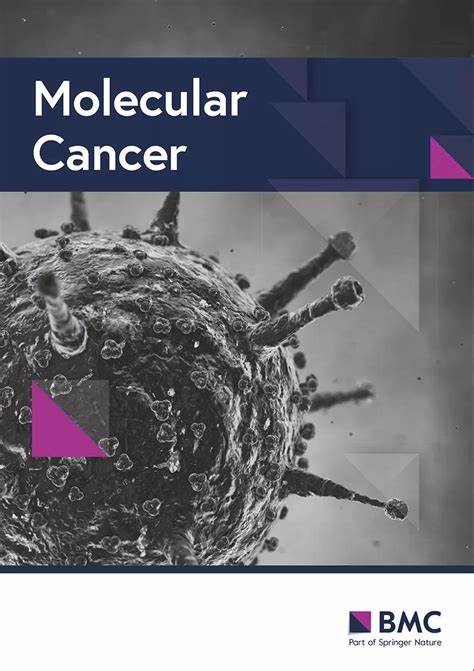在TFE3重组肾细胞癌中,ASPSCR1-TFE3融合患者对基于ICI的联合疗法反应更好
IF 27.7
1区 医学
Q1 BIOCHEMISTRY & MOLECULAR BIOLOGY
引用次数: 0
摘要
TFE3重排肾细胞癌(TFE3-rRCC)是一种罕见但高度异质性的肾细胞癌(RCC)实体,其临床治疗前景在很大程度上尚未明确。本研究旨在评估和比较不同系统治疗方法的疗效,并进一步探讨其分子相关性。研究共纳入38例转移性TFE3-rRCC患者。主要结果包括无进展生存期(PFS)、总生存期、客观反应率(ORR)和疾病控制率。对32个肿瘤进行了RNA测序。接受基于免疫检查点抑制剂(ICI)的一线联合疗法的患者比未接受ICI治疗的患者获得了更长的PFS(中位PFS:11.5个月 vs. 5.1个月,P = 0.098)。在对融合伙伴进行分层后,基于 ICI 的一线联合疗法的卓越疗效主要在 ASPSCR1-TFE3 rRCC 中观察到(中位 PFS:未达到 vs. 6.5 个月,P = 0.01;ORR:67.5% vs. 10.0%,P = 0.019),但在非 ASPSCR1-TFE3 rRCC 中几乎没有观察到。转录组数据显示,ASPSCR1-TFE3 rRCC中与ECM和胶原蛋白相关的信号转导丰富,这可能会干扰抗血管生成单药的潜在疗效。而血管生成和免疫活动在ASPSCR1-TFE3型rRCC中完全富集,这就保证了ICI加酪氨酸激酶抑制剂联合疗法能取得更好的临床疗效。目前的研究是基于融合伙伴分层比较转移性TFE3-rRCC治疗效果并研究其分子相关性的最大队列。基于 ICI 的联合疗法可作为转移性 ASPSCR1-TFE3 rRCC 患者的有效一线治疗方案。对于其他融合亚型,应进一步研究其分子机制,从而提出相应的治疗策略。本文章由计算机程序翻译,如有差异,请以英文原文为准。
Patients with ASPSCR1-TFE3 fusion achieve better response to ICI based combination therapy among TFE3-rearranged renal cell carcinoma
TFE3-rearranged renal cell carcinoma (TFE3-rRCC) is a rare but highly heterogeneous renal cell carcinoma (RCC) entity, of which the clinical treatment landscape is largely undefined. This study aims to evaluate and compare the efficacy of different systemic treatments and further explore the molecular correlates. Thirty-eight patients with metastatic TFE3-rRCC were enrolled. Main outcomes included progression-free survival (PFS), overall survival, objective response rate (ORR) and disease control rate. RNA sequencing was performed on 32 tumors. Patients receiving first-line immune checkpoint inhibitor (ICI) based combination therapy achieved longer PFS than those treated without ICI (median PFS: 11.5 vs. 5.1 months, P = 0.098). After stratification of fusion partners, the superior efficacy of first-line ICI based combination therapy was predominantly observed in ASPSCR1-TFE3 rRCC (median PFS: not reached vs. 6.5 months, P = 0.01; ORR: 67.5% vs. 10.0%, P = 0.019), but almost not in non-ASPSCR1-TFE3 rRCC. Transcriptomic data revealed enrichment of ECM and collagen-related signaling in ASPSCR1-TFE3 rRCC, which might interfere with the potential efficacy of anti-angiogenic monotherapy. Whereas angiogenesis and immune activities were exclusively enriched in ASPSCR1-TFE3 rRCC and promised the better clinical outcomes with ICI plus tyrosine kinase inhibitor combination therapy. The current study represents the largest cohort comparing treatment outcomes and investigating molecular correlates of metastatic TFE3-rRCC based on fusion partner stratification. ICI based combination therapy could serve as an effective first-line treatment option for metastatic ASPSCR1-TFE3 rRCC patients. Regarding with other fusion subtypes, further investigations should be performed to explore the molecular mechanisms to propose pointed therapeutic strategy accordingly.
求助全文
通过发布文献求助,成功后即可免费获取论文全文。
去求助
来源期刊

Molecular Cancer
医学-生化与分子生物学
CiteScore
54.90
自引率
2.70%
发文量
224
审稿时长
2 months
期刊介绍:
Molecular Cancer is a platform that encourages the exchange of ideas and discoveries in the field of cancer research, particularly focusing on the molecular aspects. Our goal is to facilitate discussions and provide insights into various areas of cancer and related biomedical science. We welcome articles from basic, translational, and clinical research that contribute to the advancement of understanding, prevention, diagnosis, and treatment of cancer.
The scope of topics covered in Molecular Cancer is diverse and inclusive. These include, but are not limited to, cell and tumor biology, angiogenesis, utilizing animal models, understanding metastasis, exploring cancer antigens and the immune response, investigating cellular signaling and molecular biology, examining epidemiology, genetic and molecular profiling of cancer, identifying molecular targets, studying cancer stem cells, exploring DNA damage and repair mechanisms, analyzing cell cycle regulation, investigating apoptosis, exploring molecular virology, and evaluating vaccine and antibody-based cancer therapies.
Molecular Cancer serves as an important platform for sharing exciting discoveries in cancer-related research. It offers an unparalleled opportunity to communicate information to both specialists and the general public. The online presence of Molecular Cancer enables immediate publication of accepted articles and facilitates the presentation of large datasets and supplementary information. This ensures that new research is efficiently and rapidly disseminated to the scientific community.
 求助内容:
求助内容: 应助结果提醒方式:
应助结果提醒方式:


